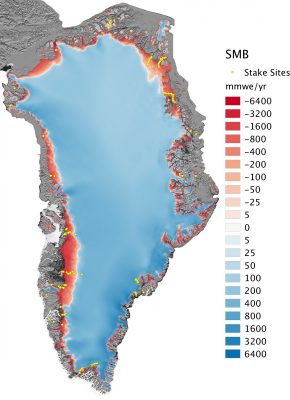The Greenland ice sheet – the world’s second largest ice mass – stores about one tenth of the Earth’s freshwater. If totally melted, this would rise global sea level by 7.4 m, affecting low-lying regions worldwide. Since the 1990s, the warmer atmosphere and ocean have increased the melt at the surface of the Greenland ice sheet, accelerating the ice loss through increased runoff of meltwater and i ...[Read More]
Image of the Week – A high-resolution picture of Greenland’s surface mass balance

Fig. 1: Surface mass balance (SMB) of the Greenland ice sheet and peripheral ice caps at 1 km resolution averaged for 1958-2015. The interior of the ice sheet (blue) accumulates mass from snowfall whereas the narrow margins (red) lose mass from runoff of meltwater. Yellow dots locate on-site measurements. At this resolution, the small ice caps and marginal glaciers are accurately resolved [Credit: Brice Noël]. Click here here to enlarge the image.
